How To Hook Up TV To RV Antenna (Step-By-Step Guide)
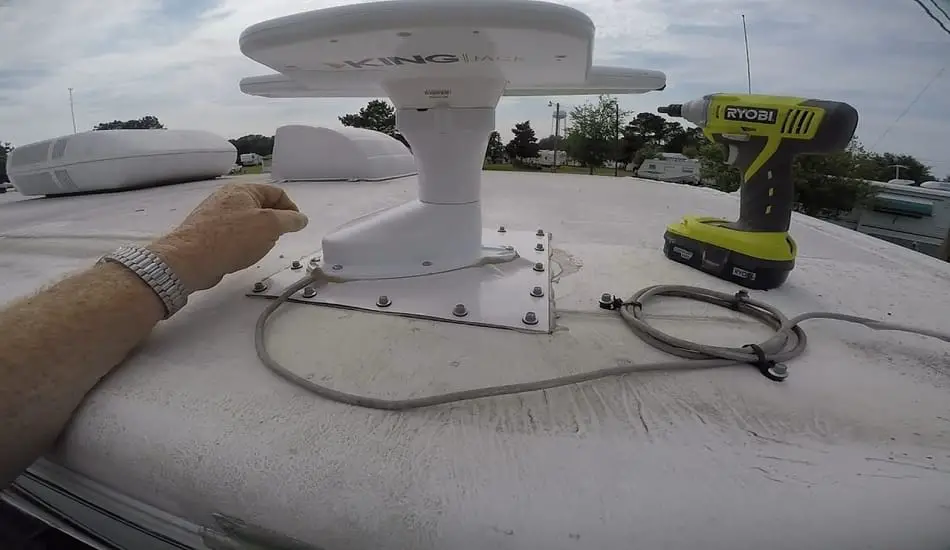
Did you know that having an RV antenna installed on your RV can get you free access to hundreds of local channels on your TV? This is not a complicated process, and it takes only a few minutes to set it up. In this article, we’ll teach you how you can do this, even if you’re never done this before. We’ll also cover with you some tips on how you can improve some of the channels by setting your antenna. So, let’s start!
Table of Contents
How To Hook Up TV To RV Antenna?
So How To Hook Up TV To RV Antenna? The first step is to connect your TV to an RV antenna by using a coaxial cable. On the TV’s backside, find the coaxial port and connect the RV antenna cable to it. Next, run a channel scan to see if it is working properly. If no program is displayed, then adjust the antenna and repeat the process.
While this may sound complicated to you, trust us it is not. We will go through this in more detail below, so don’t worry. For those who want to learn more, be also sure to read How Long Does Propane Last in an RV?
2 Ways How To Hook Up An Antenna To TV
Using An Existing Antenna
1. Connecting TV To The Antenna
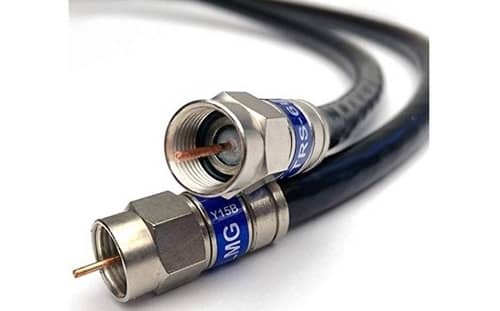
Almost all RV antennas (over-the-air antennas, High Definition (HD) antennas) are using a coaxial cable port to connect to your TV. To connect, simply screw the coaxial cable from your RV antenna on the back of your TV. Remember that some old TV models don’t have a coaxial port. If that is the case, you’ll need to use ATSC Tuner. By using this device you’ll need to plug the coaxial cable into the tuner, and then use an HDMI cable or AV cable and connect it to the back of your TV.
2. Mount Your TV
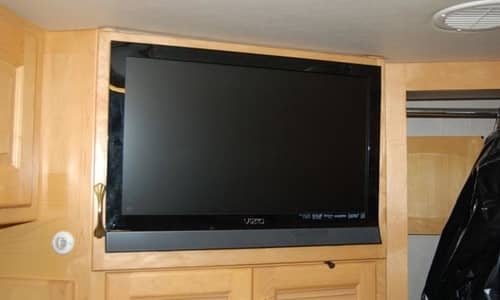
Keep in mind that some RV TVs are wall-mounted, and they will need to be removed so you can access the cable ports. Simply re-mount the TV from the wall to continue the process. For those who don’t have a wall-mounted TV, just check on the back of the TV and find a coaxial port. We recommend that you mount your TV to the wall of your RV when you finish the process.
3. Run A Channel Scan
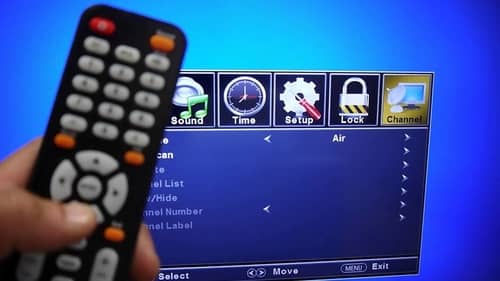
Once you’re finished with the process of connecting a coaxial cable with the TV and the TV is mounted correctly on the wall, be sure to turn the antenna “on” and do a channel scan. The channel scan is done on your TV. If you don’t know how to do this properly, be sure to use your TV’s manual to read the instructions.
You can also search on Google and find your TV model and see how it is done. If no program is found during the scan, you’ll probably need to adjust your antenna and repeat this process. This can sometimes happen.
Note! Be sure to rescan channels on your TV every month because you can potentially pick up some new channels.
Installing A New Antenna
If your RV doesn’t have an antenna, then you’ll need to install one by yourself. When choosing an RV antenna, be sure to choose a model that can be easily folded down, and that is durable so it can last for a long time. There are many RV antenna models that you can easily find on Amazon and other online shops. Here are the steps how to do this correctly:
1. Construct Your Antenna
Once you have selected your RV antenna’s model, follow the manufacturer’s instructions so you can install it correctly. You can just skip this step if you already have a pre-built model. Remember that it is always recommended to read the user manual before any installation.
2. Install Your Antenna
Find a good spot on your RV roof so you can attach the antenna. The middle of the roof is most often used, but this again depends on how your RV roof is arranged. It is up to you to decide.
Note! Be sure to check with your RV dealer or manufacturer if there is some pre-wired that is available for this system.
Keep in mind that every antenna model is different, so be sure to check your manufacturer’s instructions to see how this is done properly. If you are unsure how to do this, we recommend that you contact a professional to help you. Installing an antenna on your RV roof the wrong way can cost you more in the long run than hiring a professional to do it. Those who are using portable antennas don’t need to read this step.
3. Run the cables
The next step is to find the holes or some sort of “hook-ups” for your RV antenna cables. Be sure to run the power and use interface cables that are inside your RV. These cables need to be connected to your TV.
4. Run A Channel Scan
This step is the same as in the first scenario. Be sure your antenna is “on” and run a channel scan. For those who are doing this for the first time, we recommend that you use a TV manual or read the instructions on the Internet.
Note! Each antenna is different, so that the installation process may vary. There are RV antenna models that are portable and don’t need to be attached to the roof. Find an area that has good reception and connect your RV antenna with TV, and that’s it!
Ways To Improve RV TV Experience
Sometimes you’ll experience a problem with the TV signal, which can be bad, but it usually depends on your current location. Here we’ll give you some tips on improving that signal and setting up your RV antenna better.
TV Antenna Rotator
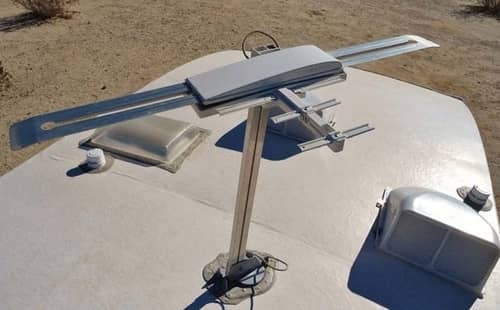
While you are traveling with your RV from one location to another, you might need to rotate your RV antenna and do the manual adjustments to get a better signal (reception). But it doesn’t make sense to do that! There are rotating antennas (remote-operated models), that you can very easily adjust to the right angle and direction to get the best possible signal.
Some TV antenna rotators come with channel-saving features. If you’re watching your favorite TV channel, the rotator on your roof will automatically move to the right angle to get the best signal for that channel. Although many TV antenna models come with this feature, you can also buy them separately if your model doesn’t have them.
TV Antenna Booster (Amplifier)
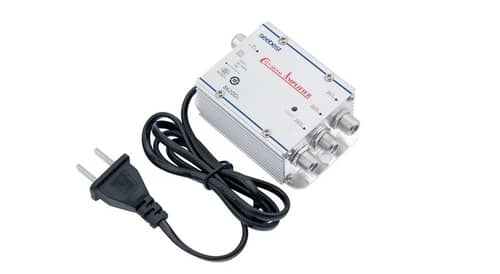
The quality of your TV signal depends also on other factors like terrain, weather, and location. With a TV antenna booster, you can easily improve the signal that your antenna is receiving. For those with an amplified TV antenna, you have signal boosting benefits. For those who have a non-amplified antenna, just attach your TV antenna booster to it, and you’ll get better signal quality.
> Get TV Antenna Booster Here <
Antenna Signal Meter
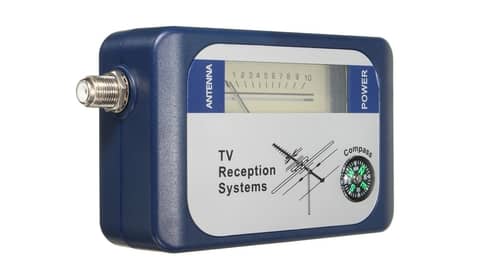
An antenna signal meter is a great tool for those who want to skip the guesswork. By using this device, you can simply test the signal strength by moving the antenna. That way, you can easily find where the strongest signal is and what local stations are in your range. The process of finding quality channels is much faster this way. The benefits of a signal meter are the following:
- Get the fine-tune picture quality by adjusting the amplification.
- Getting the volume audio signal feedback
- Rotating the antenna
Tripod Base
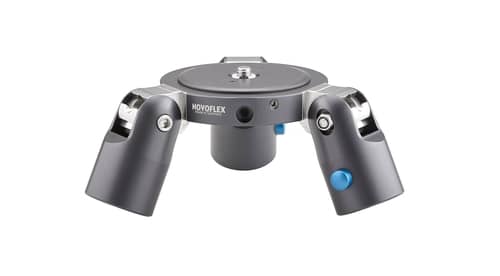
A tripod base is great for those with a portable (un-mounted) antenna. Keep in mind that when you go camping not every location will have even ground. Using tripod base mounts ensures that your RV antenna is stable and leveled up even in bad weather conditions. Some bubble-level models can help you with the alignment process.
For those who want to see how this looks, check out this YouTube video:
If you own an RV, this is a good thing to know Why RV Carbon Monoxide Detector Keeps Going Off?
FAQ: People Also Ask
Will an RV antenna work with digital TV?
RV TV antennas work very well in combination with digital TV and can scan many free channels. HDTV is also used very commonly in RVs today. Keep in mind that TV antenna channels are free, just like radio stations, if you are within the radius to pick it up.
How to get local channels on Your RV?
The best way to get local channels on your RV is to use a streaming box such as Roku or AppleTV. You can also use the free AirTV app. Once you set up everything, you can turn on the TV and watch home-based local channels in your RV.
How do I connect my TV to RV?
To properly connect your TV to RV, the interface cable must be connected with the dish/antenna to the control box. The power cable must also be connected to the control box to the dish/antenna also. Many people have placed TVs in their RVs above the driver or passenger seats.
Final Thoughts
Now that we have seen how you can connect your RV antenna to a TV, you’ll have no problem trying this by yourself. This is a very simple process, and it will not take you more than 10 minutes to do it. Just use a coaxial cable and connect it to your TV. I hope that this article has helped you and for any other questions feel free to contact us.

